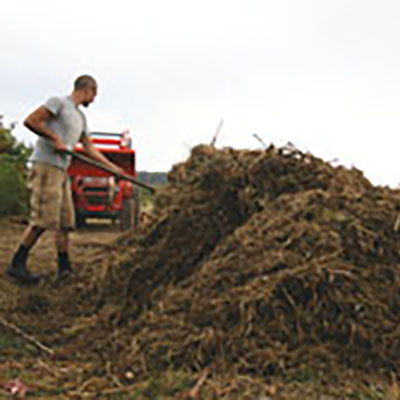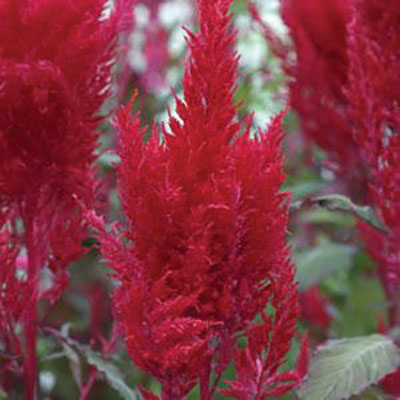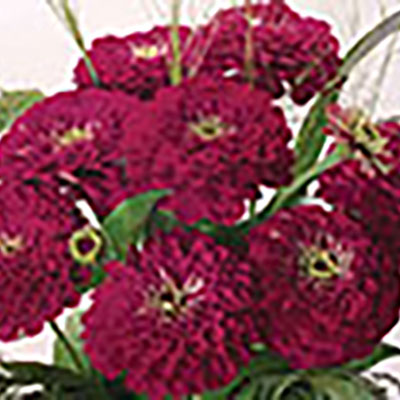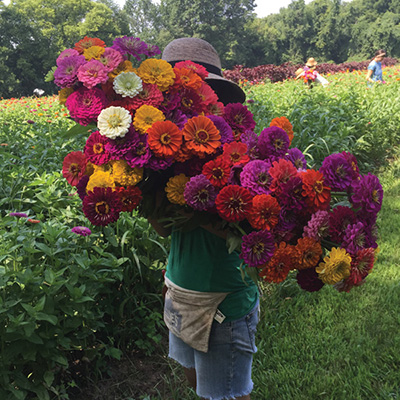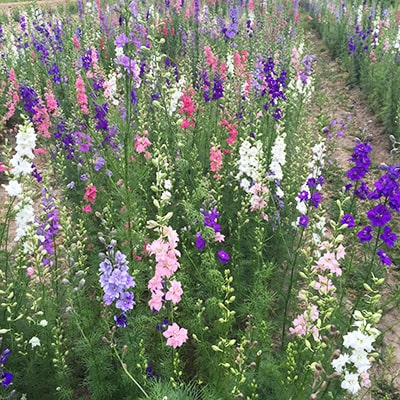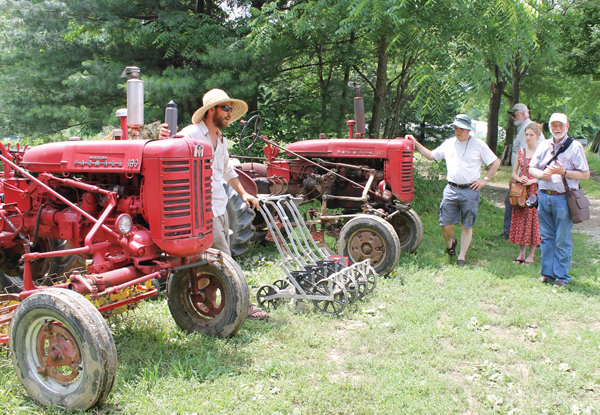
Steve Adams explains mechanical cultivation to a tour group at Sunny Meadows Flower Farm. Two Farmall tractors with cultivating sweeps and basket weeders, plus a gang of Earthway seeders to mark rows keep the flower fields tidy. Photos courtesy of Sunny Meadows.
On our farm, we create a Tillage Schedule to help us determine when beds need to be prepped in our fields. Our crop planning method works backward from sales projections, telling us when we need specific crops harvestable, and therefore when they need to go in the ground. With multiple worksheets including information like days to maturity and greenhouse weeks, we create a Field Planting Schedule that tells us when each crop is to be planted, and how many feet. Our beds are standardized to either 75- or 150-foot beds.
We then take that Field Planting Schedule to create a Field Map. Each field is numbered as is each bed. We start planting on one edge of the field, working down the field in order. We try to group things together that will be planted around the same time and have the same growth habit. Since we plant full beds, this isn’t as important as it used to be when we had a lot of half beds. In that case, pairing things together is essential to ensure you are tilling in the whole bed at once, for more efficient tractor usage.
We use our Field Map to create a Tillage Schedule based on when beds need to be ready for planting. This makes sure we stay on task with all the tractor work that needs to be done to prepare the bed. We start out by using our Massey Ferguson with 6’ King Kutter tiller to do our primary till one month before planting, followed by two shallow tills 2” deep before planting. This kills three generations of weeds while bringing very few seeds up to germinate. Soil amendments, determined by a soil test, are applied before each planting with our Agri-Fab pull-behind fertilizer drop spreader, and tilled in with the last shallow till right before planting.
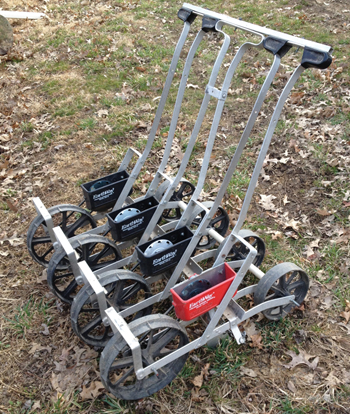
Four Earthway seeders are bolted together (“ganged”) and used for direct seeding and marking rows for transplanting, which ensures consistent spacing
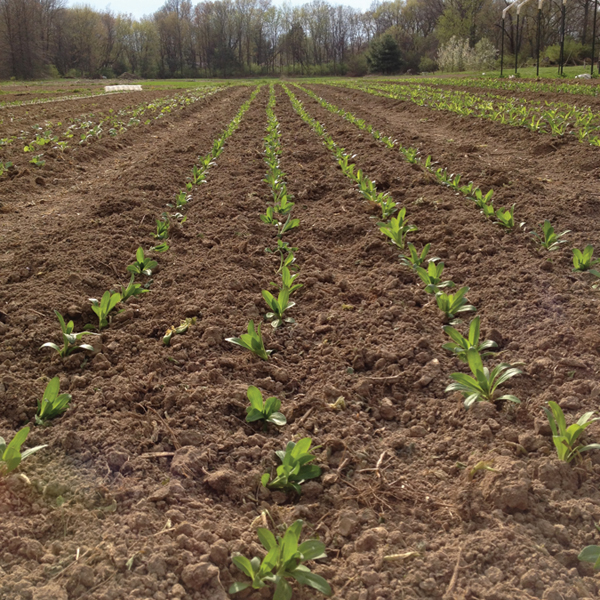
Some farmers would discourage rototilling this much, and we now understand more about the effect it has on soil health, harming the tilth and burning up nutrients quickly. As a result, this year we will be investing in some other way to break the ground for bed making, such as a disc or a mini chisel plow. We will still use the rototiller for stale bedding for now, but having another implement for incorporating cover crops or initial bed-making will ensure we aren’t creating a “plow pan” under the soil.
Creating a Tillage Schedule also helps us to plan cover crops for the year. We can see where there is a gap in planting, and figure out which cover crops will fit that timing and for what length of time the field can stay fallow. As our operation continues to grow, we have to get cover crops in while we can because there isn’t always a huge block of time or space that allows for them. Turning crops in is not accounted for unless we are replanting the beds. Overwintering cover crops are also not accounted for; beds will get tilled in when we are done harvesting and covered through the winter if possible. Last year with the late frost, we didn’t get as much winter cover in as we would have liked. Steve’s dream is to acquire more land so that more of it can be intentionally rested in cover crop for longer. Our soil is pretty healthy, but we want to keep it that way!
Mechanical cultivation
There are many methods for weed control, but for our size operation, we have chosen to use mechanical means of cultivation in the field. People often ask “How big does your operation have to be to make mechanical cultivation the best choice?” We own 10 acres, but have only 3.5 acres tillable land if you take away the driveways, greenhouse space, perennial plots, and our house and woods. We realized we needed to do something different after reading Richard Wiswall’s chapter on Production Efficiencies (see The Organic Farmer’s Business Handbook), and working through some enterprise budgets. If we wanted to increase production, we needed to have more efficient weed control to increase profitability as well.
A few years ago, we had a college student who wheel hoed all our beds. He was content out there all day, no shirt or shoes in the field, just wheel hoeing away. When he went back to college, we purchased a Farmall 100 with belly-mounted cultivating sweeps on it and standardized all of our beds to 4 rows per bed. Since it is important for the spacing to be correct, we ganged 4 Earthway seeders together to mark the rows. Even if we aren’t direct seeding, we run the ganged seeders through the bed to mark planting lines. Plants can be spaced in the row to suit their needs, but the space between rows remains the same. Everything is planted in the field in four rows, except dahlias (two rows); Salvia leucantha (one row); tuberose, lilies, and tulips (three rows).
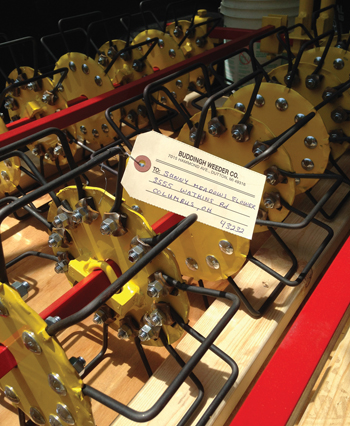
New toy: A Buddingh basket weeder allows for mechanical cultivation very close to plants.
We also use a pull-behind cultivating bar with sweeps for the tire tracks, which become the walkways. I provided more details about planting in my January 2014 article in Growing for Market. We originally thought we needed a transplanter, but since we plant four-row and smaller plots, we decided against it and instead purchased a Buddingh basket weeder.
The basket weeder is much more gentle with the plants than the cultivating sweeps, which move a lot of soil, so the basket weeder is ideal for smaller plants. Using the cultivator alone, we had to run the wheel hoe through until the plants were large enough to withstand the cultivator, but no more! With the basket weeder, we can get about 1” from the plants, which really decreased labor hours weeding. These stale bedding and cultivating methods have eliminated most of our hand weeding, except for some in-row, and those few rogue beds that need extra attention each year.
We had the basket weeder constructed for our beds - 4 rows, 10” apart on center, with the width between our tractor tires at 48”. The front sprocket on the basket weeder is larger than the back, so the first set of baskets scrapes off the top layer of soil, and then the back set of baskets moves at a faster speed and breaks it up. The key with mechanical cultivation is to get the weeds when they are small, so we try to run the cultivating tractors through once a week to stay on top of them. The first few times, the Farmall with the basket weeder will be used on the small plants; as the plants get larger, we switch to the Farmall with cultivating sweeps and tire track cultivator. This throws a bit more soil and can handle any bigger weeds that made it through the baskets. By the time plants are too large to fit under the cultivator, they are usually big enough to shade the weeds out (especially celosia, amaranth, and sunflowers). It may sound like a lot of tractor work, but it is much quicker than wheel hoeing, and especially quicker than hand weeding, with no black plastic involved. We found both our Farmall tractors on Craigslist for around $2,500 each, and the Buddingh basket weeder was $3,500 from Market Farm Implement in Friedens, Pennsylvania.
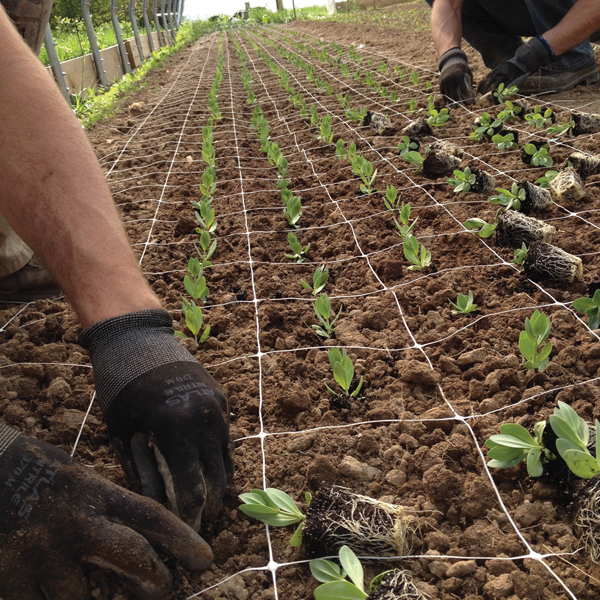
Non-mechanical cultivation
In the greenhouses, we use only a walk-behind tiller because we have permanent beds. We rip out all plant debris between each crop and use the front-end loader to take it to the compost pile. Rather than bringing the tractor in each time and having to dig out walkways, we decided to focus our energy and nutrients on the beds only. If a bed needs to be raised, we will run the tiller in the walkways to break up the soil, set up strings along the edges, and then shovel it onto the surrounding beds before bed prep. We first spread a layer of compost; add any necessary nutrients as determined by the soil test, and then till in before planting. Tilling breaks up any clods that were shoveled onto the beds. Then we use a rake to level out the bed, making sure it goes all the way to the edge by using the strings again. All weeding in the greenhouses is done by hand and with a selection of hand hoes. The wheel hoe is used in the walkways.
We use the Hortonova as a planting grid in the greenhouse (pictured above) and most cropsare now six rows per bed. Last year we were doing 5 rows per bed, but decided to add one more row and decrease the size of the walkways. This increased the number of plants we can fit into a greenhouse by the equivalent of another entire bed: 6 beds x 5 rows= 30 rows, or 6 beds x 6 rows= 36 rows. We still have 18” walkways in a 30’ wide house, which is tight, but has not significantly cut down productivity. It has increased profitability where it is most important - tunnel space, heated greenhouses especially.

At Sunny Meadows, production efficiency in the field requires orderly and consistent planting, followed by mechanical cultivation.
We only use woven black plastic landscape fabric around our perennials or the edges of greenhouses, because the last thing you want to do in the middle of the summer is weed the edge of the greenhouse! Some growers utilize this landscape plastic by burning holes at standardized spacing and then reusing it for following years. You can burn the holes with a propane torch, using a template marking the spots. Just beware there aren’t any dried leaves underneath or it turns into a much bigger hole, which happened in our hydrangea patch!
Decreasing the labor hours weeding is something every farm should strive for, to increase each crop’s profitability. We would much rather pay staff to harvest and process flowers so we can fill more orders! Since we don’t use chemical methods of weed control, we had to determine what was the best fit for our growing methods and size of operation. Our next tractor implement purchase will be a tine weeder, which gets even closer to the plants than the basket weeder and can even weed in-row, as long as plants are well-rooted.
Gretel and Steve Adams own Sunny Meadows Flower Farm in Columbus, Ohio. They can be contacted by email.

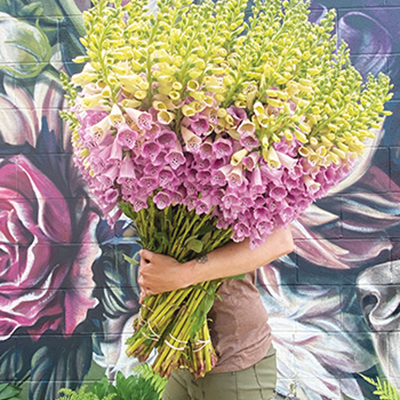
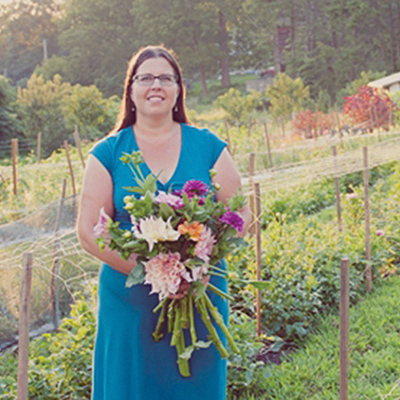
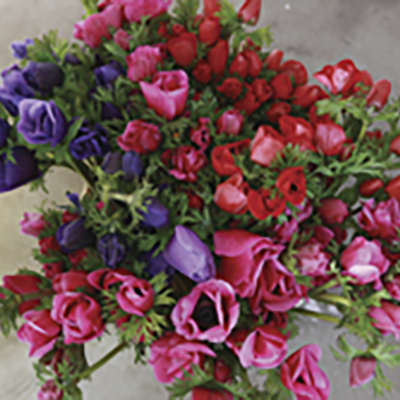
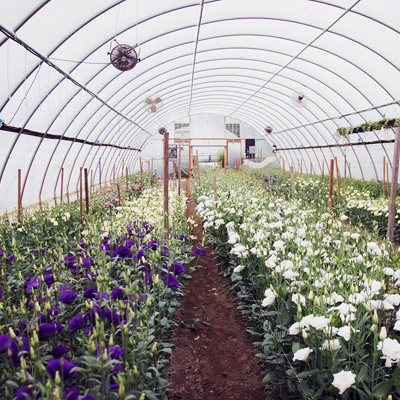
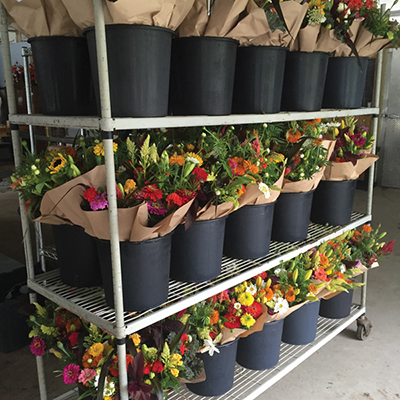

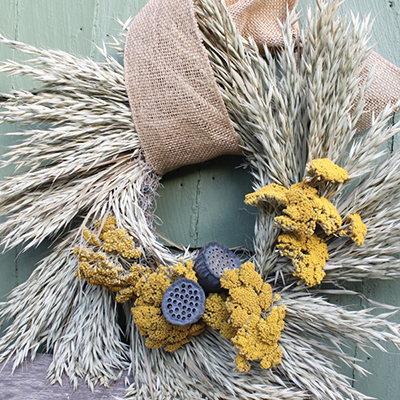


 I have been following the flower farming adventures of Pamela and Frank Arnosky, owners of Texas Specialty Cut Flowers, from the start. Their wonderful monthly column here in Growing For Market spanned more than 15 years and eventually became two fabulous books, We’re Gonna Be Rich (out of print) and Local Color (still available from GFM). When I got wind that the ASCFG was hosting one of their four conferences at the Arnoskys’ farm this winter, I flipped a gasket. Visiting their famous operation has long been a dream so with a little nudging from Lynn, my husband Chris and I hopped a plane and ventured deep into Texas hill country to learn the secrets of successful flower farming from two of the finest masters in the biz!
I have been following the flower farming adventures of Pamela and Frank Arnosky, owners of Texas Specialty Cut Flowers, from the start. Their wonderful monthly column here in Growing For Market spanned more than 15 years and eventually became two fabulous books, We’re Gonna Be Rich (out of print) and Local Color (still available from GFM). When I got wind that the ASCFG was hosting one of their four conferences at the Arnoskys’ farm this winter, I flipped a gasket. Visiting their famous operation has long been a dream so with a little nudging from Lynn, my husband Chris and I hopped a plane and ventured deep into Texas hill country to learn the secrets of successful flower farming from two of the finest masters in the biz!